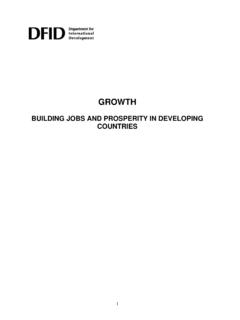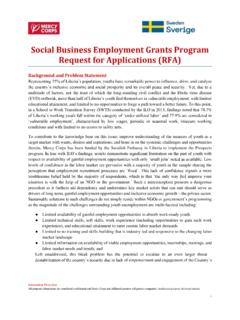Transcription of OECD Employment Outlook 2015 - Institución Futuro
1 OECD Employment Outlook 2015 . OECD Employment Outlook OECD Employment Outlook 2015 . Volume 2011/Number of issue, Year of edition Author (affiliation or title), Editor Tagline Groupe de travail/Programme (ligne avec top 220 mm). This work is published under the responsibility of the Secretary-General of the OECD. The opinions expressed and arguments employed herein do not necessarily reflect the official views of OECD member countries. This document and any map included herein are without prejudice to the status of or sovereignty over any territory, to the delimitation of international frontiers and boundaries and to the name of any territory, city or area. Please cite this publication as: OECD ( 2015 ), OECD Employment Outlook 2015 , OECD Publishing, Paris. ISBN 9789264234185 (print). ISBN 9789264239531 (PDF). ISBN (HTML). Series/Periodical: ISSN 1013-0241 (print). ISSN 1999-1266 (online). The statistical data for Israel are supplied by and under the responsibility of the relevant Israeli authorities.
2 The use of such data by the OECD is without prejudice to the status of the Golan Heights, East Jerusalem and Israeli settlements in the West Bank under the terms of international law. Photo credits: Cover Ikoneimages/Inmagine. Corrigenda to OECD publications may be found on line at: OECD 2015 . You can copy, download or print OECD content for your own use, and you can include excerpts from OECD publications, databases and multimedia products in your own documents, presentations, blogs, websites and teaching materials, provided that suitable acknowledgment of the source and copyright owner is given. All requests for public or commercial use and translation rights should be submitted to Requests for permission to photocopy portions of this material for public or commercial use shall be addressed directly to the Copyright Clearance Center (CCC) at or the Centre fran ais d'exploitation du droit de copie (CFC) at FOREWORD.
3 Foreword T he OECD Employment Outlook provides an annual assessment of key labour market developments and prospects in member countries. Each edition also contains chapters focusing on specific aspects of how labour markets function and the implications for policy in order to promote more and better jobs. This year's chapters cover five topics: minimum wages; skills and wage inequality; activation policies for more inclusive labour markets; earnings mobility, labour market risk and long-term inequality; and job quality in emerging economies. Reference statistics are also included. The 2015 OECD Employment Outlook is the joint work of staff of the Directorate for Employment , Labour and Social Affairs. It has greatly benefited from contributions from national government delegates. However, the Outlook 's assessments of each country's labour market prospects do not necessarily correspond to those made by the national authorities concerned.
4 This report was jointly edited by Mark Keese and Paul Swaim, and is based on contributions from Stijn Broecke, Andrea Garnero, Herwig Immervoll and Pascal Marianna (Chapter 1), Glenda Quintini and Stijn Broecke (Chapter 2), David Grubb and Kristine Langenbucher (Chapter 3), Alexander Hijzen and Andrea Garnero (Chapter 4), Sandrine Cazes, Paolo Falco and Balint Menyhert (Chapter 5). Research assistance was provided by Dana Blumin, Sylvie Cimper, S bastien Martin, Agn s Puymoyen and Paulina Granados Zambrano. Editorial assistance was provided by Gabriela Bejan, Natalie Corry, Monica Meza-Essid and Marl ne Mohier. OECD Employment Outlook 2015 OECD 2015 3. TABLE OF CONTENTS. Table of contents Editorial: Time is running out to help workers move up the jobs ladder .. 11. Acronyms and abbreviation.. 15. Executive summary .. 17. Chapter 1. Recent labour market developments with a focus on minimum wages.. 19. Key findings.
5 20. Introduction.. 22. 1. Recent labour market developments .. 23. 2. Special section on the role of minimum wages after the crisis .. 34. Conclusions .. 52. Notes.. 53. References .. 55. Annex Country-level data from OECD economic projections .. 59. Chapter 2. Skills and wage inequality .. 63. Key findings .. 64. Introduction.. 65. 1. Setting the scene .. 66. 2. Skills and wage inequality .. 69. 3. Skills and wage gaps between groups .. 84. 4. Robustness checks: The role of institutions .. 87. Conclusions .. 92. Notes.. 93. References .. 95. Annex Wage inequality in the PIAAC countries .. 99. Annex Methodology for the wage simulations .. 100. Annex A simple supply and demand framework to analyse differences in wage inequality .. 103. Chapter 3. Activation policies for more inclusive labour markets .. 105. Key findings .. 106. Introduction.. 108. 1. What role do activation policies play for more inclusive labour markets?
6 111. 2. Motivation: Making the most of existing Employment opportunities .. 117. 3. Employability: Employment services and programmes enhancing the employability of jobseekers .. 122. 4. Opportunities: Expanding available and accessible earnings opportunities .. 135. 5. Institutions at the centre of successful activation strategies .. 142. OECD Employment Outlook 2015 OECD 2015 5. TABLE OF CONTENTS. Conclusions .. 151. Notes.. 152. References .. 155. Annex Unemployment benefit registration procedures, job-search requirements and participation in active labour market programmes (ALMPs) .. 162. Annex Supplementary material on job-search methods .. 165. Chapter 4. The quality of working lives: Earnings mobility, labour market risk and long-term inequality .. 167. Key findings .. 168. Introduction.. 170. 1. A statistical portrait of mobility and inequality across countries and socio-economic groups .. 171. 2. What types of careers are associated with low long-term earnings?
7 182. 3. Policies to promote rewarding and secure careers .. 191. Conclusions .. 200. Notes.. 201. References .. 204. Annex Further results .. 209. Chapter 5. Enhancing job quality in emerging economies .. 211. Key findings .. 212. Introduction.. 214. 1. Job quality in emerging economies: A cross-country analysis .. 215. 2. How hard is it to escape low-quality informal jobs?.. 231. 3. Policy implications .. 237. Conclusions .. 243. Notes.. 244. References .. 247. Annex Empirical methods .. 250. Annex Social transfers in emerging economies .. 254. Annex Informality .. 259. Annex Well-being and job quality .. 262. Statistical annex.. 263. A. Harmonised unemployment rates in OECD countries .. 266. B. Employment /population ratios by selected age groups .. 267. C. Labour force participation rates by selected age groups .. 270. D. Unemployment rates by selected age groups .. 273. E. Employment /population ratios by educational attainment, 2013.
8 276. F. Labour force participation rates by educational attainment, 2013 .. 277. G. Unemployment rates by educational attainment, 2013 .. 278. H. Incidence and composition of part-time Employment .. 279. I. Incidence and composition of involuntary part-time Employment .. 280. J. Incidence and composition of temporary Employment .. 281. K. Incidence of job tenure, less than 12 months .. 282. L. Average annual hours actually worked per person in Employment .. 285. M. Incidence of long-term unemployment, 12 months and over.. 286. 6 OECD Employment Outlook 2015 OECD 2015 . TABLE OF CONTENTS. N. Real average annual wages and real unit labour costs in the total economy.. 289. O. Earnings dispersion and incidence of high and low pay .. 290. P. Relative earnings: gender, age and education gaps .. 291. Q. Public expenditure and participant stocks in labour market programmes in OECD countries, 2012 and 2013 .. 292. Tables Proportion of employees in 2014 who were paid under the 2015 level of minimum wage in Germany, and increase of the wage bill implied by the new minimum, by industry, area and firm size.
9 36. Statutory minimum wage systems in OECD, key partner and accession countries .. 40. The effect of minimum wages on Employment : What meta-analyses show.. 47. Recent and projected macroeconomic developments .. 60. Recent and projected macroeconomic developments .. 61. Relative impact of skills on wage inequality .. 80. Impact on inequality of including temporary and part-time jobs .. 89. Incidence, distribution and size of bonuses, by country .. 90. The impact of skills on wage inequality, controlling for institutional factors: Evidence from regression analysis .. 91. Wage inequality in the PIAAC countries .. 99. Proportions (%) high-, medium- and low-skilled, by country .. 103. Unemployment benefit registration procedures and application routes .. 162. Job-search requirements and participation in active labour market programmes (ALMPs).. 163. Methods used during previous four weeks to find work .. 165. Promoting quality jobs through labour market policies and social protection.
10 242. Social transfer schemes and data sources used to measure public insurance by country .. 255. Group level regressions of job quality on worker characteristics and informality .. 259. Figures Recent and projected developments in real GDP growth, Employment growth and unemployment rate in OECD countries .. 23. The jobs recovery remains incomplete .. 24. Unemployment remains significantly above its pre-crisis levels in the majority of OECD countries.. 25. Long-term unemployment has risen in a large majority of countries, but sharp hikes are confined to only a few, Q4 2007 and Q4 2014 .. 26. Youth unemployment has reached very high levels in some OECD countries .. 27. NEET rates among youth in OECD countries .. 28. Incidence of temporary Employment has declined in some countries, but risen in others .. 30. The incidence of part-time Employment has continued to increase .. 31. Many of the jobs destroyed as a result of the crisis will not come back in the recovery.




